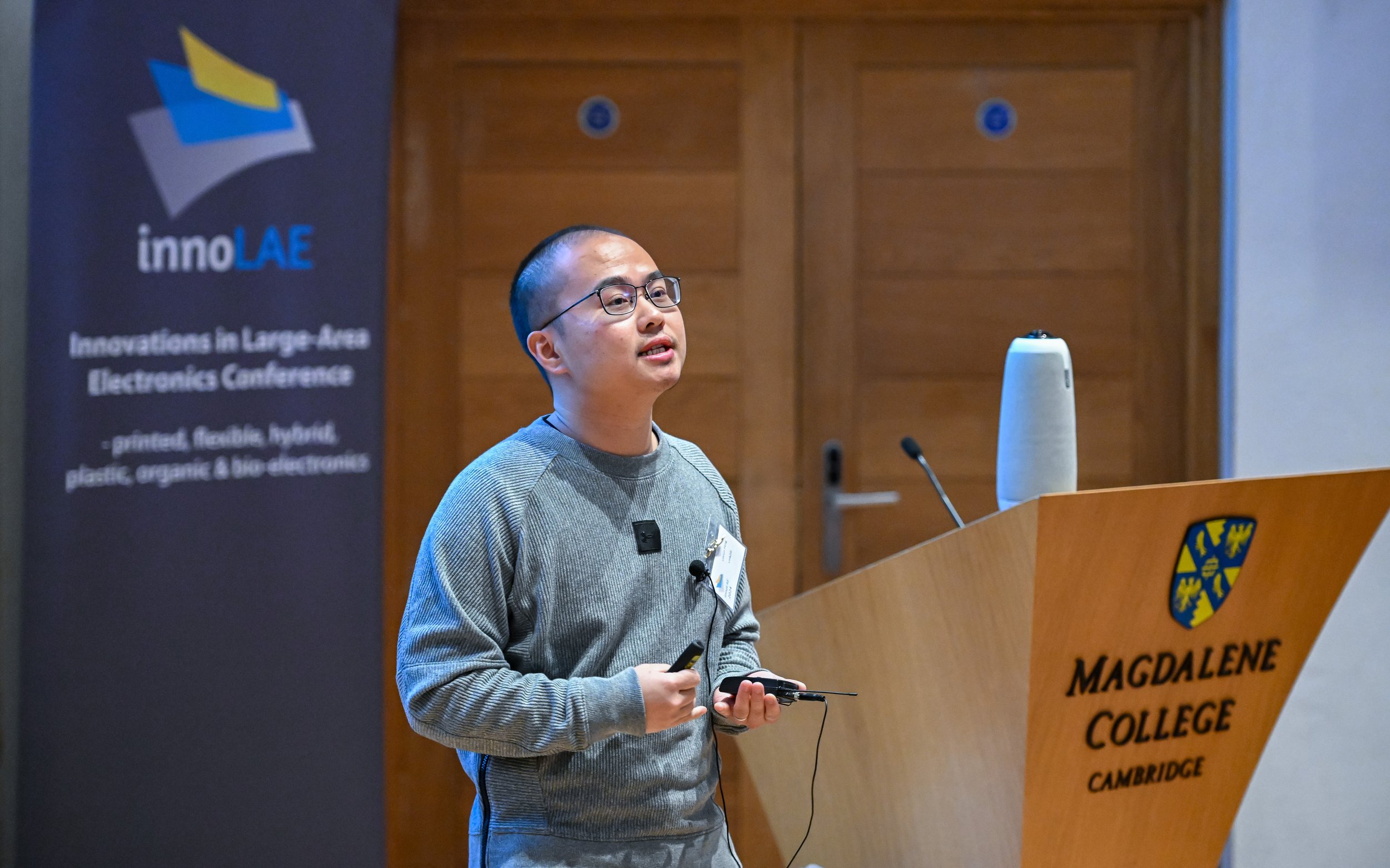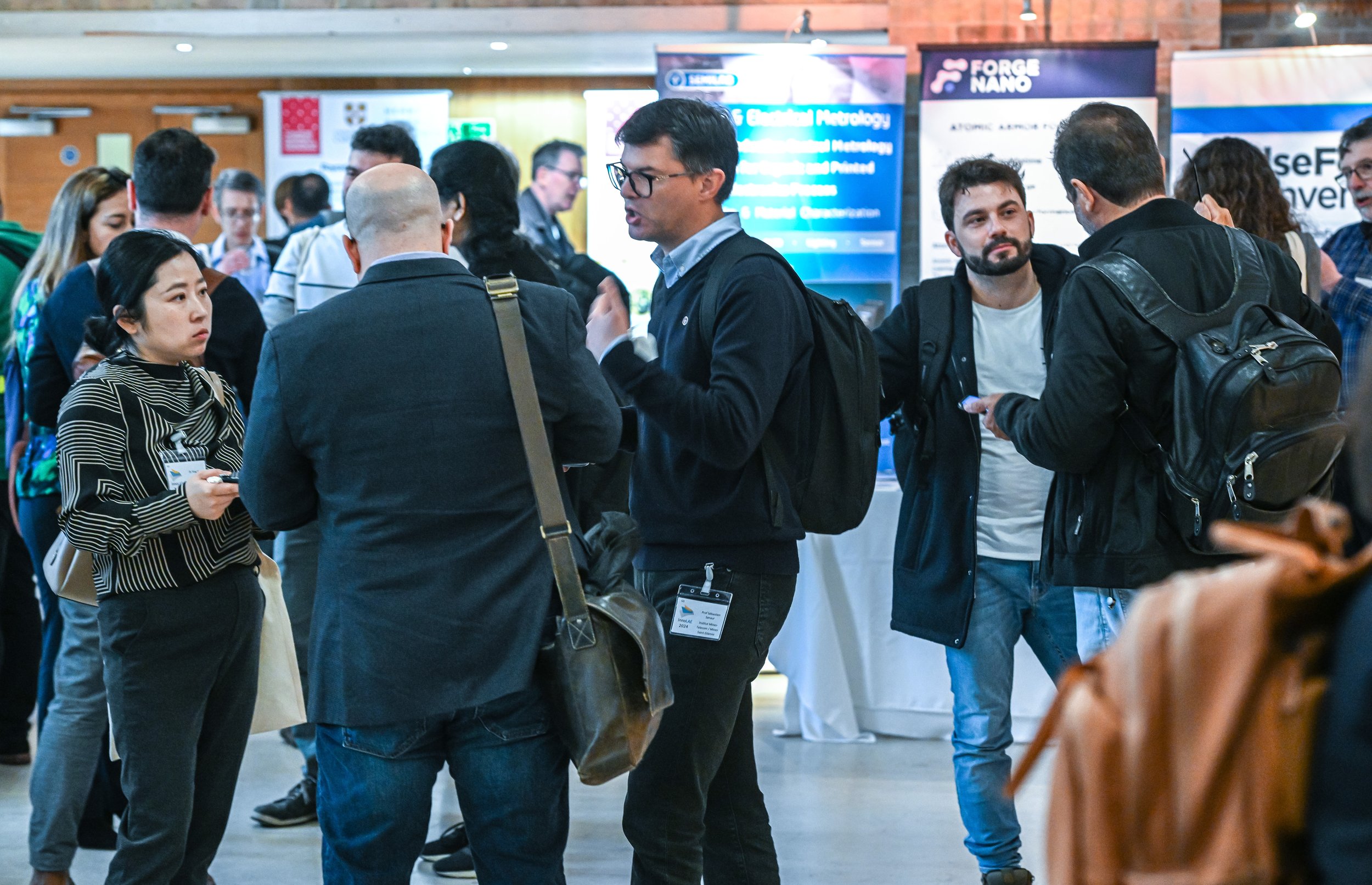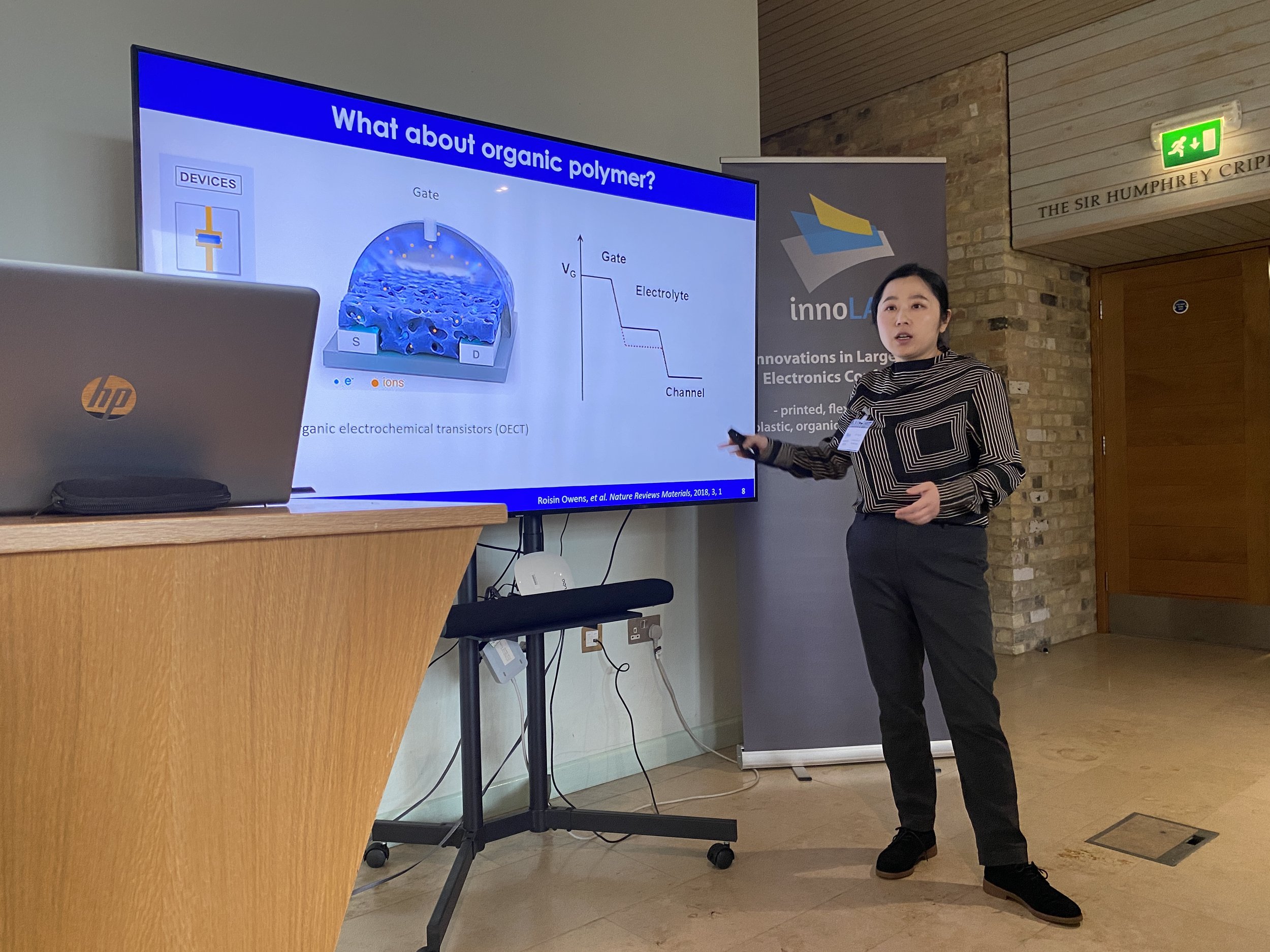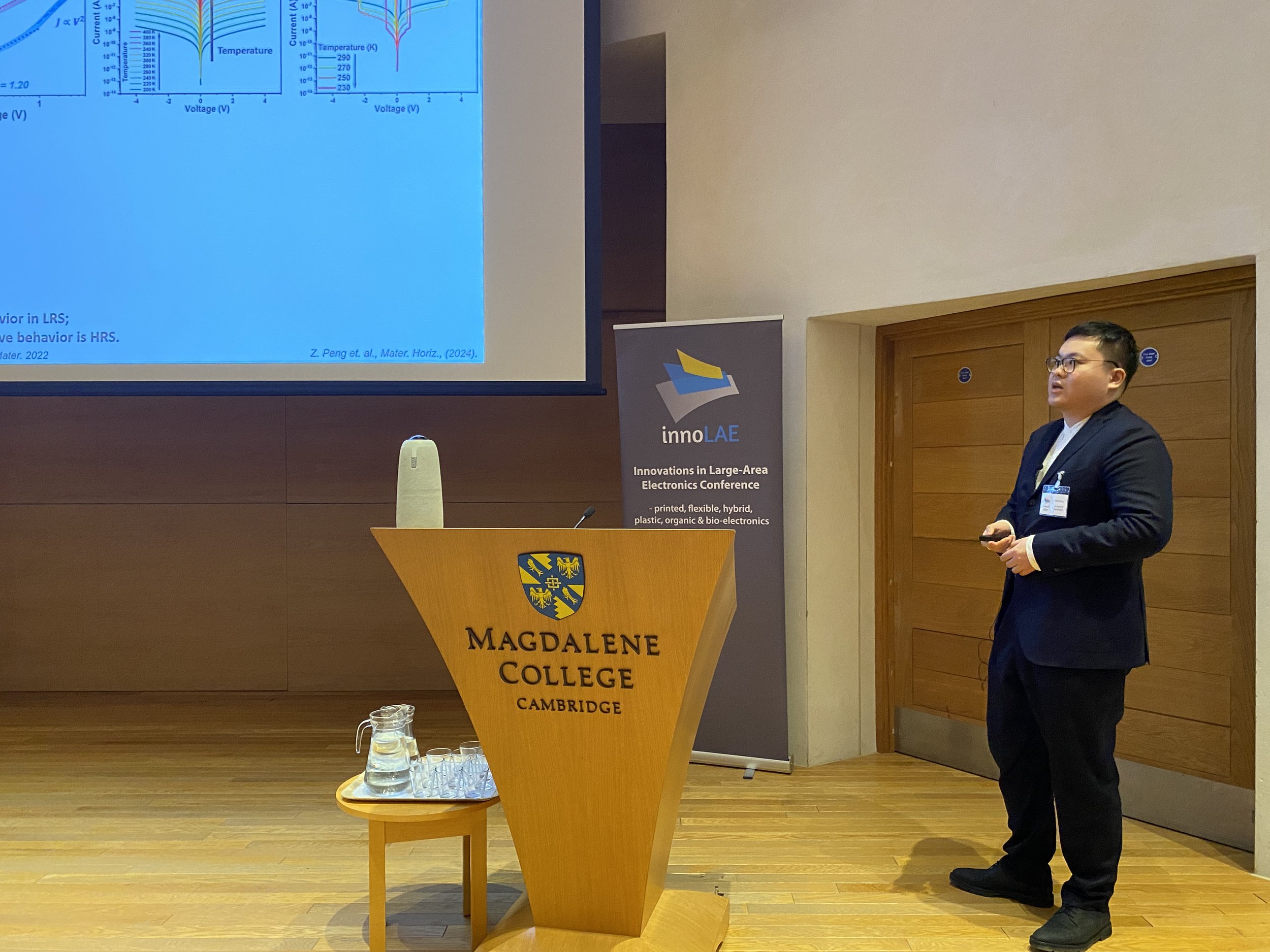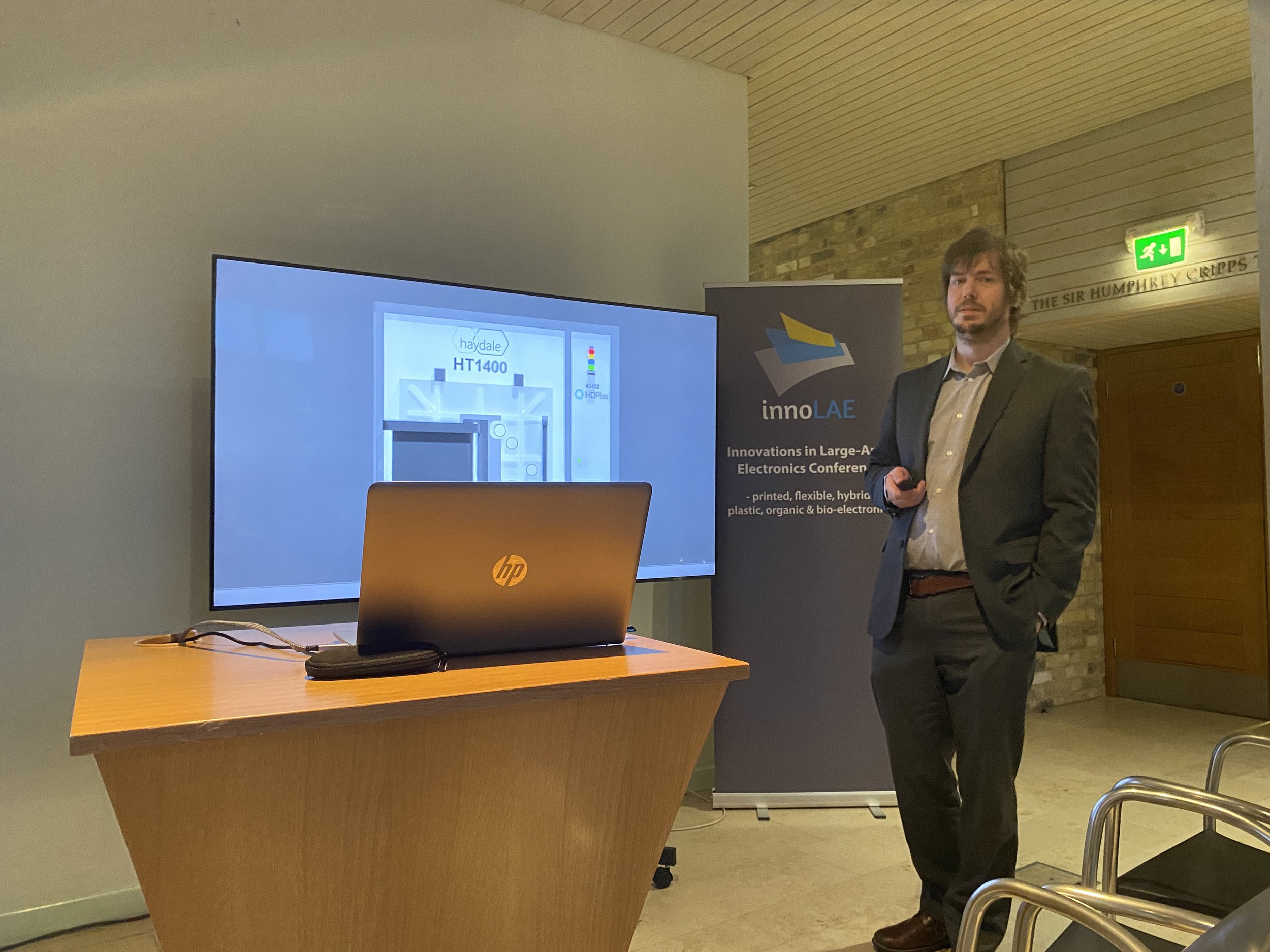Gallery of InnoLAE 2024 Photos
A gallery of photographs from InnoLAE 2024, including speakers - professional photos to be added soon!
Unleashing New Frontiers with TFT Semiconductor for Your Materials and Devices
Are you having trouble validating photoelectric detection studies (e.g., perovskite X-rays, visible light, near-infrared, and ultraviolet) or with real-time luminescent device displays?
LinkZill collects the needs of our consumers in driving, reading, and testing TFT (thin-film transistor). Building upon these requirements, we've introduced a series of standard systems known for their cost-effectiveness, precision, portability, applicability, real-time display capabilities, fast data storage, and data sharing functionalities, offering a comprehensive service from TFT chip to supporting electronic systems and processing technology.
TruEbox MR64
Designed for collecting sensor arrays and imaging current signals, LinkZill's TruEbox 03MR (64×64) supports arrays up to 64×64 resolution. All current data is transmitted to Android terminal devices via Wi-Fi, producing a 256 grey-level image based on current strength. This matrix readout system is ideal for light or pressure imaging using thin-film transistor (TFT) array chips.
TruEbox MD256
Our latest High-Resolution TFT Array Chips and Compatible Matrix Driver Systems, TruEbox 04MD (256×256), enhance luminescent material display performance. With support for a maximum array resolution of 256×256 and a frame rate of 30-60Hz, animations are displayed with improved clarity.
Additionally, our portable testing systems offer real-time measurement of capacitance, resistance, and current, with fast response speed, high resolution, and data-sharing capabilities, suitable for various scenarios.
TruEbox 01RC
TruEbox 01RC delivers real-time, accurate resistance/capacitance data, enabling applications in sensor characterization, portable electronic product development, sports health monitoring, biomedical testing, and more.
TruEbox 02CM
Providing multichannel bias voltages (seven) and measuring multichannel currents (eight) in real-time, TruEbox 02CM meets the needs of I-V characteristic scanning and dynamic current monitoring for various components, facilitating biomedical testing, portable electronic product development, sports health monitoring, and other scenarios.
TruEbox TFT-IV
TruEbox TFT-IV is a portable electrical test and analysis system for semiconductors, offering three bias voltage channels and one current channel, with IdVg and IdVd modes. Monitoring real-time I-t or I-V curves, it shares measured data via a mobile app, aiding in biomedical testing, portable electronic product development, sports health monitoring, and various other scenarios.
Up to now, the TruEbox series has assisted over three hundred customers worldwide, facilitating the publication of more than 200 high-impact papers in journals such as Nature Biomedical Engineering, Nature Communications, and Advanced Materials.
TFT Customized Design and Supply
LinkZill values the various needs of our customers and customizes the design of our TFT chips accordingly. TFT chip designs from different customers will be pieced together and integrated for overall tape-out and manufacturing.
Our TFT device types include a-Si, IGZO, LTPS, Organic TFT, LTPO, among others. We offer customization options for substrate materials (glass or plastic) and sizes (up to G6.5 line) to perfectly align with our client's specific requirements.
LinkZill was founded in January 2019, headquartered in Hangzhou, Zhejiang Province, with R&D and marketing center in Cambridge, UK. In 2023, LinkZill established Hangzhou TFT Bio-semiconductor R&D Center. LinkZill aims to make technology serve people better and more efficiently with the vision of “Linking zillions of people and technology. Linking zillions of hearts with love”.
Furthermore, LinkZill's TFT semiconductor biochip platform has been successfully applied in high-throughput DNA synthesis, precise droplet manipulation, in vitro diagnostics (IVD), and biological signal sensing.
Dedicated to expanding our global presence, LinkZill actively seeks partnerships to collaboratively build a community. For more information on our products, contact us at info@linkzill.com and visit our website https://www.linkzill.com/.
How Paragraf Magnetic Sensors are Enabling the Quantum Revolution
Quantum computing has recently transitioned from a series of theoretical concepts to real-world, practical applications. In 2022 alone, investment in quantum computing totalled $2.35 billion, demonstrating the market’s confidence in its future.
The quantum environment is expanding and transforming, and Paragraf’s graphene Hall sensors (GHS) are uniquely placed to play a pivotal role in its development.
What is quantum computing?
The fundamental distinction between classical and quantum computing lies in the basic unit of information. The classical bit is a binary unit whose state is expressed as either ‘0’ or ‘1’. Quantum computers rely instead on the qubit, an abstraction that mimics the behaviour of atomic particles. A qubit occupies a ‘superposition’, which is a continuous state between ‘0’ and ‘1’. By manipulating the state of a qubit, a quantum computer can account for the full range of probabilities contained within its superstate. Qubits, like electrons in atoms, interact with one another through a process called ‘entanglement’ where one qubit mirrors its counterpart, expanding the amount of information available from their manipulation.
The nuances of qubit behaviour empower quantum computers to take on extremely complex problems beyond the reach of their classical counterparts. As such, quantum computing allows for applications that require especially complex tasks, such as cryptography, modelling chemical reactions and enhancing machine learning/AI. When applied to these tasks, quantum stands to have substantial impact on financial services, pharmaceutical development, supply chain management and manufacturing.
Within that broad definition of the quantum process, there are multiple approaches to quantum computing. Each of these technologies is being developed by prominent tech giants and they have all demonstrated strengths in particular applications.
How is Paragraf enabling these technologies?
Qubits are highly susceptible to magnetic fields. As such, magnets are employed in the operation of quantum computer and external magnetic fields pose a threat to their operation. Quantum hardware systems often require cryogenic temperatures in order to reduce environmental effects. Paragraf’s cryogenic GHS are uniquely able to perform at extreme low temperatures while maintaining linearity across a wide range of field strengths, making them applicable to each of these tasks.
Low-Field Quantum Applications
Qubits are incredibly small and vulnerable to a variety of external forces. As such, the mechanisms necessary for the quantum computer to function are very fragile. Outside influences, such as external fields, can disrupt the function of qubits within a quantum system.
Magnetic fields work by exerting force on charged particles, meaning that qubits encountering those fields are susceptible to influence that would distort their quantum states; and magnetic fields are nearly ubiquitous. Any electrical current moving through a wire will produce a magnetic field and the instruments that operate a quantum computing system require extensive wiring. Other electric components and moving parts in the vicinity of a quantum computer produce magnetic fields, as well. Even the Earth’s own magnetic field is strong enough to potentially disrupt the computer’s output.
Controlling the magnetic environment in a quantum computer requires employing shielding tactics that neutralize the impact of outside fields, either through physical barriers made of Mu metal, superconducting materials that redirect these fields or the use of additional magnets that are tuned to cancel out the external fields. Paragraf’s cryogenic GHS, owing to their high sensitivity, can detect magnetic fields down to 10s of µT in strength, allowing the shielding mechanisms to be accurately calibrated.
Heat also has the potential to disrupt the operation of quantum computers. By exciting the qubits within a system through the introduction of thermal energy, higher temperatures present the threat of ‘decoherence’, where qubits’ entanglement with one another is disrupted. Protecting against decoherence requires quantum computers to function at extremely low temperatures, down to around 10 mK.
This means that the Hall sensors employed to detect external fields must also prove resilient to extremely low temperatures. Graphene’s two-dimensional structure, when married to Paragraf’s contamination-free deposition process, presents a highly robust sensing surface at extreme temperatures, down to mK levels. Further, the low power requirements of our sensor reduce the threat of thermal and magnetic interference produced by its associated circuitry.
High-Field Quantum Applications:
The operation of manipulating qubits within the specific quantum systems discussed below entails the use of large magnetic fields.
Superconductors
Superconducting quantum computers are unique among quantum architectures in that their physical qubits – often referred to as ‘artificial atoms’ – are macroscopic, so they are larger and more robust than the qubits used in competing approaches. These designs employ low temperatures and Josephson junctions, which are tunnelling devices that allow electrons to flow across a barrier with no voltage applied. They further engage external magnetic fields to control the energy levels of superconducting qubits and to enable initialization, gate operations, and readout. These magnetic fields can be precisely controlled to perform quantum gates and quantum algorithms.
Quantum Dots
Quantum dot qubits, unlike their superconductor counterparts, are nanoscale particles comprising a small, countable number of silicon electrons. In computing functions, these particles act as tunnels that render quantum information when voltage levels in the source-drain window that encapsulates the quantum dots are varied. The addition of quantum dots in the tunnelling function provides a degree of scalability that produces more-complex computations. The application of magnetic fields is key to this control of the voltage in the system.
Cold Atoms
Cold atom qubits comprise isolated atoms which are ‘tweezered’ by lasers to manipulate their superposition. Even more than other quantum applications, cold atom operations entail extremely low temperatures (<1 mK). While magnets are not the primary tool for performing quantum operations here, they are often used in the process of isolating and cooling the atoms to set up those operations.
The manipulation of quantum qubits – even those as relatively large as superconductor qubits – requires exceptionally precise application of magnetic fields. That precision entails accurate calibration of those magnetic tools. Paragraf’s GHS technology is particularly capable of providing such a degree of accuracy in the unique environment of quantum computers.
Once most magnetic sensors encounter fields above a particular threshold, the corresponding readings increase in plateaus and sharp inclines rather than in a continuous, proportional trendline. This is referred to as the Quantum Hall effect (QHE) and it makes these conventional devices unusable in cryogenic applications where the strength of the field varies.
Paragraf’s graphene deposition enables us to modify the sensitivity of our sensors. Through experimenting with the GHS-C, we have found we can delay the onset of QHE so that we are producing sensors that maintain their linearity up to ~30T, as demonstrated at the High Field Magnet Laboratory in Nijmegen, Netherlands.
Additional Applications for Paragraf's Cryogenic Sensors:
Paragraf GHS's cryogenic applications are not confined to quantum computing. Superconducting magnets, essential for MRI, particle accelerators, fusion energy research, maglev trains, and NMR spectroscopy involve low temperatures and a wide range of magnetic field strengths. These next-generation technologies require precisely the solutions our sensors provide. Moreover, the demands of space exploration, characterized by extremely low temperatures, highlight the suitability of Paragraf's cryogenic sensors for aerospace applications.
As quantum computing evolves and permeates various industries, Paragraf's cryogenic GHS will emerge as a critical enabler, ensuring the stability, precision, and efficiency of quantum operations. From shielding quantum computers to advancing research applications in space and other fields, Paragraf's innovative sensor technology plays a pivotal role in shaping the future of quantum computing and beyond.
Email: enquiries@paragraf.com
Tel: 01223 739782
Come and hear more from Paragraf at innoLAE 2024!
4th Keynote speaker talk details
Fourth InnoLAE Keynote Speaker
Tracking nitrogen in soil with printed electronics
Prof Ana Claudia Arias
Professor of Electrical Engineering and Computer Sciences
University of California, Berkeley
Prof Arias received her PhD in Physics from the University of Cambridge, UK in 2001. Prior to that, she received her master and bachelor degrees in Physics from the Federal University of Paraná in Curitiba, Brazil in 1997 and 1995 respectively.
She joined the University of California, Berkeley in January of 2011. Prof. Arias was the Manager of the Printed Electronic Devices Area and a Member of Research Staff at PARC, a Xerox Company. She went to PARC, in 2003, from Plastic Logic in Cambridge, UK where she led the semiconductor group.
Her research focuses on the use of electronic materials processed from solution in flexible electronic systems. She uses printing techniques to fabricate flexible large area electronic devices and sensors.
Happy New Year from the InnoLAE team!
We hope you had a good break and are ready for a new year of technology development, and especially making plans to attend InnoLAE 2024!
Join us for a great line-up of speakers and posters at innoLAE 2024
See our website for the full programme of Keynote, Invited and submitted oral presentations. innoLAE 2024 gives ample opportunity for delegates to network, share their work and discuss mutual interests - part of our mission to encourage the growth of the industry.
Find out more about our Keynote Speakers
Find out more about our Invited Speakers
Throughout the event, during coffee breaks, lunches and a reception, you will be able to browse the great variety of posters covering all of the conference topics.
This is a great opportunity to meet researchers and hear about their latest results.
Our Programme Committee will also be reviewing all of the posters and awarding a prize to the best poster, as well as a prize for the best speaker.
Check out our previous winners here →
Book an exhibition table!
Join the growing list of exhibiting companies and organisations benefiting from the opportunities presented by the innoLAE platform.
Highlight your company's expertise, and demonstrate your products/services
Generate leads and form new partnerships
Recruit new talent for your team
Increase brand awareness across a targeted audience
There are sponsorship opportunities to suit all needs.
For further details see our website: https://innolae.org/sponsorship-options
or email us at info@innolae.org
Press Release: IMI Europe announces InnoLAE 2024 Programme
IMI Europe announces the full programme for its popular InnoLAE (Innovations in Large Area Electronics) Conference. InnoLAE 2024 will be held at Cripps Court, Magdalene College, Cambridge, UK on 21-22 February 2024, with short courses on LAE technologies held the day before.
InnoLAE 2024 Conference
21-22 February 2024
The InnoLAE (Innovations in Large Area Electronics) Conference programme highlights the most innovative and exciting aspects of large area and non-conventional electronics. InnoLAE 2024 promises a high calibre programme combining plenary addresses from internationally renowned speakers, two parallel tracks of oral presentations, a poster session with the latest research results and an exhibition with leading companies and organisations showcasing their latest products and developments.
InnoLAE conference topics include:
· Manufacturing LAE components and systems
· High performance materials for LAE
· Novel devices & systems for LAE
· Bioelectronics
· Applications of LAE
· Sustainability and energy efficiency
After the highest ever number of abstract submissions, a number of high-quality papers has been chosen by the conference Programme Committee to join the Keynote and Invited Speakers in the speaker lineup, with the rest making up the poster session.
We have four excellent Keynote speakers from leading international organisations:
· Prof Ana Claudia Arias, University of California, Berkeley
· Prof Alberto Salleo, Stanford University
· Prof Jonathan Rivnay, Northwestern University
· Dr Carl Naylor, Intel
The Conference programme includes contributions from world-renowned companies, international research and technology organisations and top speakers from academia, representing organisations including: Footfalls & Heartbeats, University of Cambridge, Åbo Akademi University, University of California San Diego (UCSD), Imperial College London, Polytechnique Montreal, King Abdullah University of Science and Technology (KAUST), University of Bologna, Tampere University, NOVA School of Science and Technology (FCT-NOVA), University of Leeds, IDTechEx, University of Minho, University College London, Nottingham Trent University, Paragraf, KU Leuven, Institut de Ciencia de Materials de Barcelona, Swansea University, Cambridge Display Technology, Tsinghua University, University of Manchester, Institut Mines- Telecom / Mines Saint-Etienne, University of Strathclyde, X-LAB / Universiteit Hasselt, IQ Biozoom, University of Glasgow, Flexenable and CSEM.
There is also a selection of technical short courses led by industry and academic experts, presented the day before the Conference:
· Organic Bioelectronics
· Bioelectronic Devices Based on Electrical-Double-Layers
· Wet Processing Technologies for LAE
“After our first year back to face-to-face conferences in 2023, we are excited to have the highest ever number of abstract submissions for the 2024 conference,” comments Tim Phillips, Managing Director IMI Europe. “We have a great new central Cambridge location for InnoLAE 2024 and look forward to a successful event.”
For more details on the event as well as the full conference programme, see the InnoLAE website, www.innolae.org.
innoLAE 2024 Late News Posters
Late News Posters Still Being Accepted
We want to see your posters at InnoLAE!
Each poster will have an allocated space on the wall in the conference networking area. Stand near your poster during the breaks to discuss your research with other event attendees. There will be a prize for the best poster voted for by the InnoLAE Programme Committee.
If you are unable to travel we will also accept remote posters. Send us your printed poster before the event and we will display it for you. You can also record a short 5 min video explaining your poster, covering key questions.
A visible presence at innoLAE offers many benefits, including the chance to expand your network, collaborative and business opportunities, within the large-area electronics community. Innovative online sponsorship options are available.
For full sponsorship details, visit our website or email us.
Short Courses At InnoLAE 2024
On Tuesday 20 February, the day before the main conference, we are running a programme of technical short courses covering key topics.
We have a slot available on Tuesday morning for equipment vendors or academics who would like to cover a technical topic. Please contact us info@innolae.org
Organic Bioelectronics
20 February 2024 (AM)
This course will cover what bioelectronics is and why it holds so much promise for meeting today's unmet medical needs, with a focus on organics, a class of materials extremely suitable for the fabrication of state-of-the-art bioelectronic devices. In this context, we will discuss why conducting polymers’ unique set of features allowed them to enter the world of bioelectronics, giving rise to the era of Organic Bioelectronics.
Bioelectronic Devices Based on Electrical Double-Layers
20 February 2024 (PM)
The Bioelectronic Devices Based On Electrical-Double-Layers: Fundamentals, Characterisation & Design course focuses on electrical methods to characterise devices that use electrical double-layers for bioelectronic sensing. These devices encompass a wide array of applications, such as skin-adherent devices for monitoring physiological changes on the skin's surface or electrophysiological signals. A critical aspect of developing these types of bioelectrical devices lies in understanding the design principles that yield optimal sensing performance. This involves careful consideration of device geometry and a judicious selection of materials used in their fabrication, which will be covered in this course.
Wet Processing Technologies for LAE
20 February 2024 (PM)
This course covers the inks and printer technology required for deposition techniques including screen, inkjet and flexo/gravure printing. The short course also covers coating techniques such as doctor blade and slot die, drawdown, spin and spray coating. In each case the advantages, disadvantages and technological challenges of each technique will be covered, along with issues arising in scale up for manufacture.
Discounts are available if you attend the conference as well, or if you register for more than one course.
innoLAE 2024 Programme Announcement!
It is our great pleasure to announce the Conference Programme for innoLAE 2024!
After detailed consideration by the Programme Committee, a number of high quality submissions has been chosen to join the Keynote and Invited Speakers in the excellent speaker lineup. The programme includes contributions from world-renowned companies, international research and technology organisations and top speakers from academia.
We also have an excellent lineup of poster presentations and it's not too late to be part of the innoLAE 2024 programme! We are accepting late news posters up to the day before the conference. Submit your abstract online here.
innoLAE 2024 Speakers represent organisations including:
Sponsor or Exhibit at innoLAE 2024
Join the growing list of companies using innoLAE to raise brand awareness and promote their products and services to an audience of researchers, manufacturers, end users and decision makers.
Third Keynote Speaker
Is the Future 2D?
Dr Carl Naylor
SRC Program Manager & Research Scientist
Intel
Carl H. Naylor is the SRC Program manager, alternate SAB rep for JUMP2.0, and Research Scientist with Intel Corporation. He received his B.A. and M.S. degree in physics from the University Joseph Fourier (Grenoble, France), followed by a Ph.D degree in physics from the University of Pennsylvania (Philadelphia, USA). He has held multiple research positions with universities across the globe: in southeast Asia, western Europe, and across north America.
He joined Intel as a Senior Research Engineer with Intel Components Research in the Novel Device Materials group, where he developed and synthesized novel nanomaterials, and searched for unique applications where they can be implemented across an Intel chip. He is now with the Corporate University Research team focused on Intel’s external engagements with Academia.
He holds over 50 co-authored publications in peer reviewed journals, over 50 U.S. patents filed, and numerous industrial and academic accolades.
innoLAE 2024 Sponsorship & Exhibition
The innoLAE Conference & Exhibition positions you in front of researchers and developers across a wide range of printed, flexible and bio-electronics applications. Exhibiting at the event gives you the opportunity to be at the forefront of the industry, presenting your expertise and products to your target audience.
Highlight your company’s expertise
Reach a selected technical community
Find out about the latest research
Generate new leads, partnerships and sales
Conduct market research
Launch and demonstrate a new product
Sponsorship/exhibition packages for innoLAE 2024
The main packages include an exhibition space, a presentation slot and other options depending on the level chosen. We also have non-exhibition sponsorship options available.
Second Keynote Talk Confirmed
Organic Mixed Conductors for Bioelectronics
Prof Jonathan Rivnay
Professor of Biomedical Engineering
Northwestern University
Jonathan Rivnay is a Professor in the Department of Biomedical Engineering at Northwestern University. Jonathan earned his B.Sc. in 2006 from Cornell University. He then moved to Stanford University where he earned a M.Sc. and Ph.D. in Materials Science and Engineering, studying the structure and electronic transport properties of organic electronic materials. In 2012, he joined the Department of Bioelectronics at the Ecole des Mines de Saint-Etienne in France as a Marie Curie post-doctoral fellow, working on conducting polymer-based devices for bioelectronics. Jonathan spent 2015-2016 as a member of the research staff in the Printed Electronics group at the Palo Alto Research Center (PARC, a Xerox Co.) before joining the faculty at Northwestern in 2017. He is a recipient of the Faculty Early Career Development (CAREER) award from the National Science Foundation (2018), and a research fellowship from the Alfred P. Sloan Foundation (2019), and was named a Materials Research Society Outstanding Early Career Investigator (2020).
First Keynote Speaker for innoLAE 2024
Ions, Electrons and Polymers: Fast Ion Insertion Towards GHz Iontronics
Prof Alberto Salleo
Professor and Department Chair
Department of Materials Science and Engineering
Stanford University
Alberto Salleo is currently Professor of Materials Science and Department Chair at Stanford University. Alberto Salleo holds a Laurea degree in Chemistry from La Sapienza and graduated as a Fulbright Fellow with a PhD in Materials Science from UC Berkeley in 2001. From 2001 to 2005 Salleo was first post-doctoral research fellow and successively member of research staff at Xerox Palo Alto Research Center. In 2005 Salleo joined the Materials Science and Engineering Department at Stanford as an Assistant Professor. While at Stanford, Salleo won the NSF Career Award, the 3M Untenured Faculty Award, the SPIE Early Career Award, the Tau Beta Pi Excellence in Undergraduate Teaching Award, and the Gores Award for Excellence in Teaching, Stanford’s highest teaching award. He has been a Clarivate Highly Cited Researcher since 2015 and was elected to the European Academy of Sciences in 2021, a Fellow of the Materials Research Society in 2022, and a Member of the Academia Europaea in 2023.



